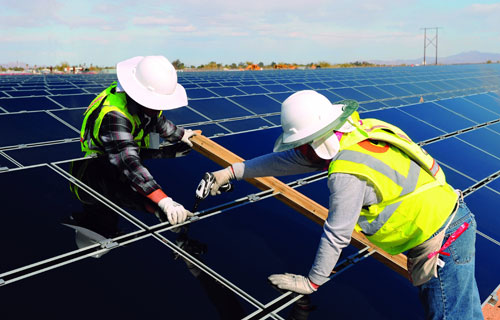Sunday, 28/12/2025 | 01:40 GMT+7
The strategy clearly defines that the electricity authority are responsible for purchasing all electricity produced from the use of renewable energy sources in their managed area to connect it to the national grid.
The expense for renewable energy sources generated electricity shall be accounted for in the price of electricity set by the electricity authority, sufficiently calculated and included in the retail electricity tariff structure and revenue through sales of electricity. The power projects using renewable energy sources for electricity generation are priotized for connection to the national grid. The connection cost and other eligible expenses incurred in the grid units (power transmission and power distribution units) due to purchasing the electricity produced from renewable energy sources are included in the cost of transmission, and distribution.
Electricity sale price is determined in accordance with conditions of different areas and the characteristics of the electricity generation technology from various renewable energy sources, following the principle of promoting the development and use of renewable energy, to ensure the capital return for investors to recover the costs and earn a reasonable profit.

Regarding self-regulating power system using independent power sources to generate electricity from renewable energy sources, the investors are expected to make proposals for the electricity prices and proposition of total sum of support from the state budget, to be submitted directly to relevant ministries for evaluation and then reported to the Prime Minister for approval. The total sum of support shall be extracted and/or deducted from the Fund for Sustainable Energy Development.
The projects for development and use of renewable energy sources are exempted from import duties on goods imported to form fixed assets for the project; the imported raw materials, supplies and semi-finished products which are not locally manufactured, for production of the project under the provisions of the current law on export tax, import tax; are exempted from corporate income taxes or eligible for tax reduction as applicable to projects in the field of investment incentives stipulated by the current laws.
In the future, to develop renewable energies, Vietnam should encourage and mobilize all possible resources from the community and the people to improve the access to modern energy sources with reliability and reasonable price. It is to promote the development and use of renewable energy sources, to increase the supply of domestic energy, gradually to increase the proportion of renewable energy sources in the production and consumption of national energy, to reduce dependence on fossil fuels, to contribute to ensuring energy security, climate change mitigation, environmental protection and sustainable socio-economic development.
Regarding the biomass energy, it will be prioritized for power generation, biogas, biomass briquettes directly used as fuel and liquid bio-fuels, to increase the utilization rate of waste from industrial crops and agricultural plants, for energy generating purposes taking from 45% in 2015 increased to 50% in 2020, 60% in 2030 and 70% in 2050; the rate of processing animal waste for energy purposes (biogas) should also increase from about 5% in 2015 to 10% in 2020, to 50% in 2030, and by 2050 most of animal waste is properly handled; the proportion of urban waste treated for energy purposes from negligible levels at present to 30% in 2020, 70% in 2030 and most are utilized for energy generating purposes in 2050.
Regarding the wind power, it will be prioritized for development on land; the research and development of offshore wind power and on the continental shelf will start beyond 2030. The target for wind power generation is to increase from 180 million kWh in 2015 to about 2.5 billion kWh in 2020; approximately 16 billion kWh in 2030 and about 53 billion kWh in 2050. To increase the wind power generation in total electricity yield from negligible levels today to reach about 1.0% in 2020, 2.7% in 2030 and around 5.0% in 2050.
Regarding the solar energy, it is expected that solar electricity would increase from 10 million kWh in 2015 to about 1.4 billion kWh in 2020; about 35.4 billion kWh in 2030 and about 210 billion kWh in 2050. It is also planned to increase the rate of solar electricity in total electricity production from negligible levels at present to approximately 0.5% in 2020, about 6% in 2030 and 20% in 2050. In particular, it is necessary to develop the devices that use solar energy to provide heat for the households; industrial production, agricultural production and services.
Trong Tan








 Webinar 2: “Financial Support for Energy Efficiency Enterprises – Opportunities and Challenges”
Webinar 2: “Financial Support for Energy Efficiency Enterprises – Opportunities and Challenges”
 Vietnamese enterprises achieve green growth and cut costs through energy efficiency
Vietnamese enterprises achieve green growth and cut costs through energy efficiency
 Capacity Building for Program Implementing Entity
Capacity Building for Program Implementing Entity
 Enhance Energy Efficiency Knowledge for Managers of Cement Industrial Enterprises
Enhance Energy Efficiency Knowledge for Managers of Cement Industrial Enterprises
 Capacity building for participating financial institutions of the VSUEE Project
Capacity building for participating financial institutions of the VSUEE Project
 Capacity building for participating financial institutions in Ho Chi Minh City
Capacity building for participating financial institutions in Ho Chi Minh City
 Strengthening capacity for energy management officers of local government agencies
Strengthening capacity for energy management officers of local government agencies